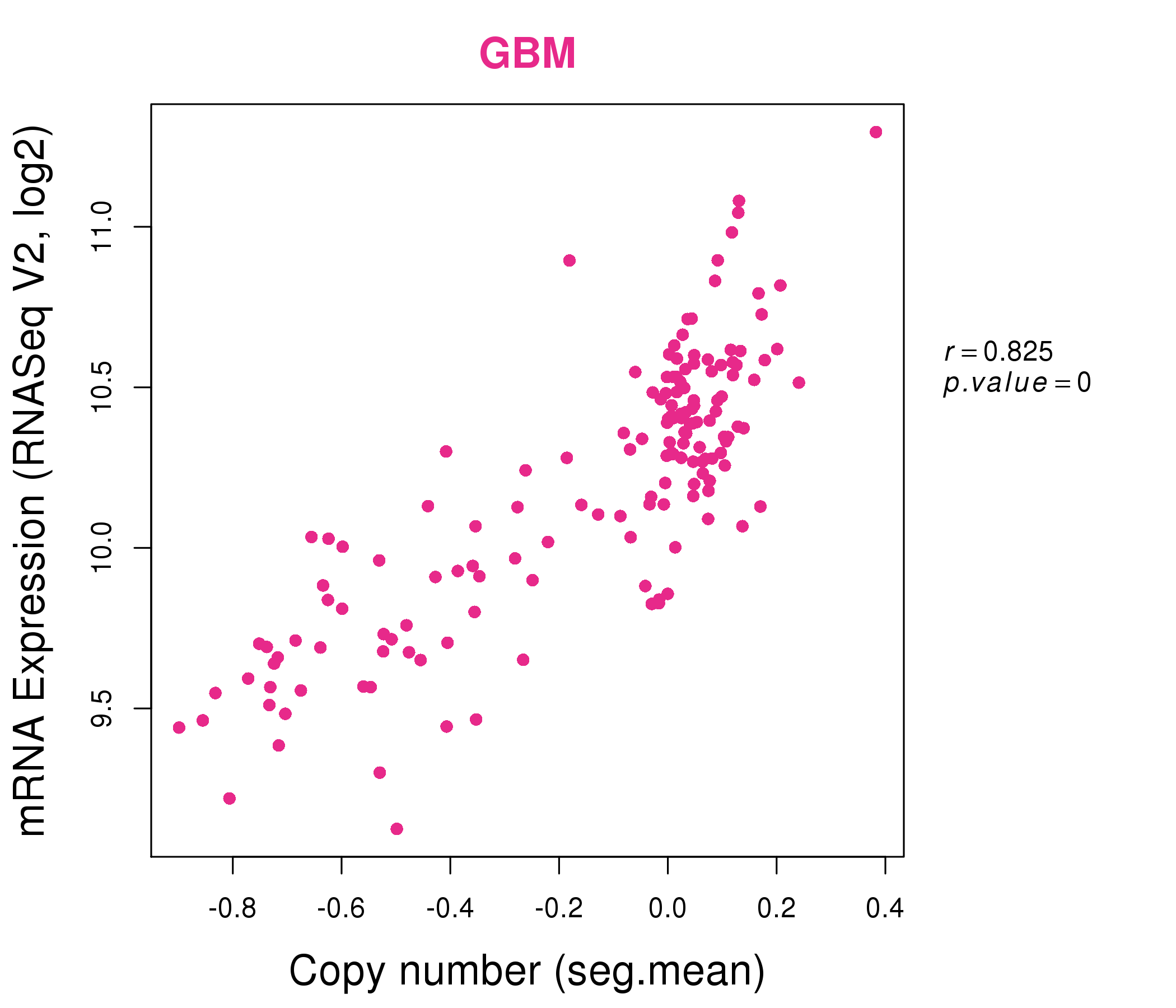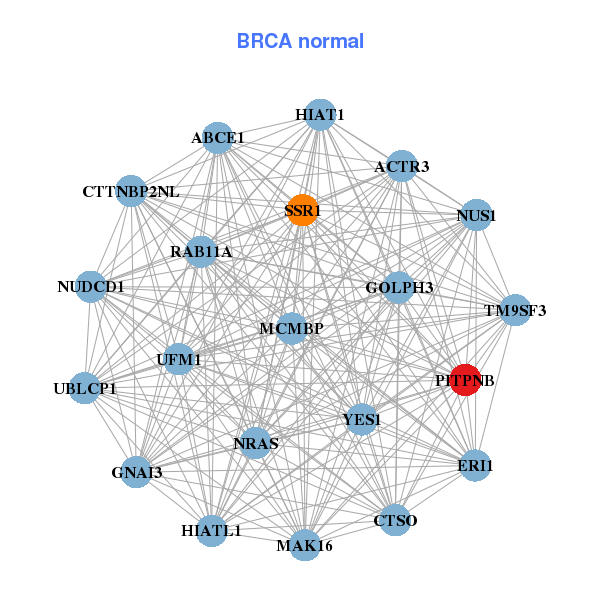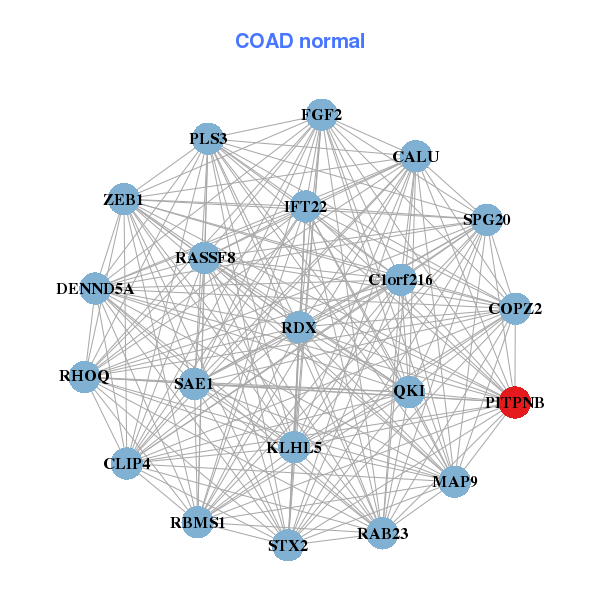|
||||||||||||||||||||||||||||||||||||||||||||||||||||||||||||||||||||||||||||||||||||||||||||||||||||||||||||||||||||||||||||||||||||||||||||||||||||||||||||||||||||||||||||||||||||||||||||||||||||||||||||||||||||||||||||||||||||||||||||||||||||||||||||||||||||||||||||||||||||||||||||||||||||||||||||||||||||||||||
| |
| Phenotypic Information (metabolism pathway, cancer, disease, phenome) |
| |
| |
| Gene-Gene Network Information: Co-Expression Network, Interacting Genes & KEGG |
| |
|
| Gene Summary for PITPNB |
| Top |
| Phenotypic Information for PITPNB(metabolism pathway, cancer, disease, phenome) |
| Cancer | CGAP: PITPNB |
| Familial Cancer Database: PITPNB | |
| * This gene is included in those cancer gene databases. |
|
|
|
|
|
| . | ||||||||||||||||||||||||||||||||||||||||||||||||||||||||||||||||||||||||||||||||||||||||||||||||||||||||||||||||||||||||||||||||||||||||||||||||||||||||||||||||||||||||||||||||||||||||||||||||||||||||||||||||||||||||||||||||||||||||||||||||||||||||||||||||||||||||||||||||||||||||||||||||||||||||||||||||||||
Oncogene 1 | Significant driver gene in | |||||||||||||||||||||||||||||||||||||||||||||||||||||||||||||||||||||||||||||||||||||||||||||||||||||||||||||||||||||||||||||||||||||||||||||||||||||||||||||||||||||||||||||||||||||||||||||||||||||||||||||||||||||||||||||||||||||||||||||||||||||||||||||||||||||||||||||||||||||||||||||||||||||||||||||||||||||||||
| cf) number; DB name 1 Oncogene; http://nar.oxfordjournals.org/content/35/suppl_1/D721.long, 2 Tumor Suppressor gene; https://bioinfo.uth.edu/TSGene/, 3 Cancer Gene Census; http://www.nature.com/nrc/journal/v4/n3/abs/nrc1299.html, 4 CancerGenes; http://nar.oxfordjournals.org/content/35/suppl_1/D721.long, 5 Network of Cancer Gene; http://ncg.kcl.ac.uk/index.php, 1Therapeutic Vulnerabilities in Cancer; http://cbio.mskcc.org/cancergenomics/statius/ |
| REACTOME_PHOSPHOLIPID_METABOLISM REACTOME_PI_METABOLISM REACTOME_METABOLISM_OF_LIPIDS_AND_LIPOPROTEINS | |
| OMIM | |
| Orphanet | |
| Disease | KEGG Disease: PITPNB |
| MedGen: PITPNB (Human Medical Genetics with Condition) | |
| ClinVar: PITPNB | |
| Phenotype | MGI: PITPNB (International Mouse Phenotyping Consortium) |
| PhenomicDB: PITPNB | |
| Mutations for PITPNB |
| * Under tables are showing count per each tissue to give us broad intuition about tissue specific mutation patterns.You can go to the detailed page for each mutation database's web site. |
| - Statistics for Tissue and Mutation type | Top |
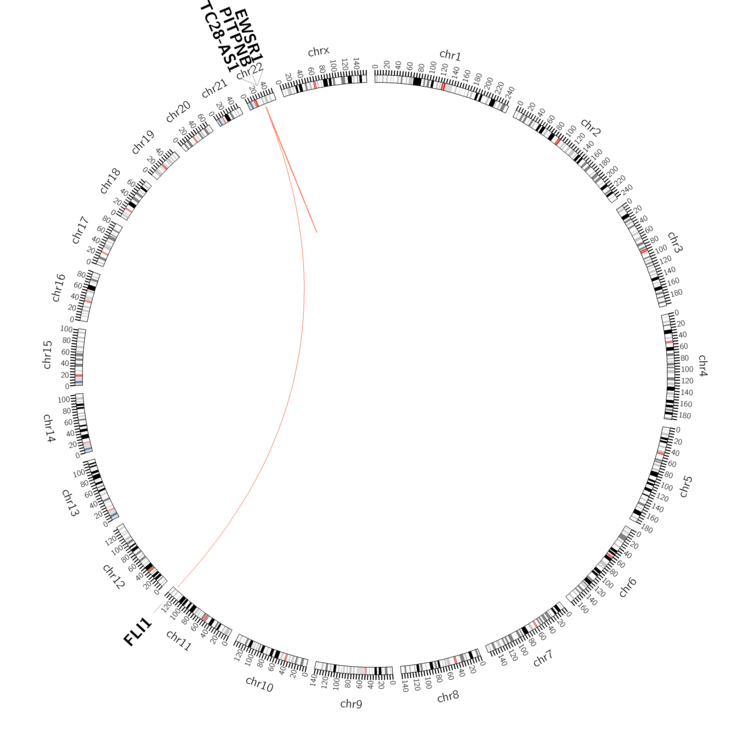 |
| - For Inter-chromosomal Variations |
| * Inter-chromosomal variantions includes 'interchromosomal amplicon to amplicon', 'interchromosomal amplicon to non-amplified dna', 'interchromosomal insertion', 'Interchromosomal unknown type'. |
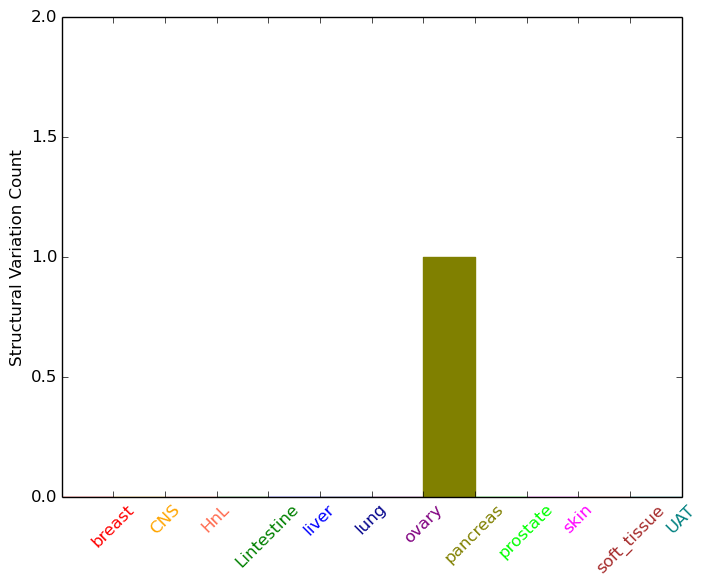 |
| - For Intra-chromosomal Variations |
| * Intra-chromosomal variantions includes 'intrachromosomal amplicon to amplicon', 'intrachromosomal amplicon to non-amplified dna', 'intrachromosomal deletion', 'intrachromosomal fold-back inversion', 'intrachromosomal inversion', 'intrachromosomal tandem duplication', 'Intrachromosomal unknown type', 'intrachromosomal with inverted orientation', 'intrachromosomal with non-inverted orientation'. |
 |
| Sample | Symbol_a | Chr_a | Start_a | End_a | Symbol_b | Chr_b | Start_b | End_b |
| ovary | PITPNB | chr22 | 28314232 | 28314252 | TTC28-AS1 | chr22 | 28337206 | 28337226 |
| pancreas | PITPNB | chr22 | 28283809 | 28283829 | EWSR1 | chr22 | 29687328 | 29687348 |
| cf) Tissue number; Tissue name (1;Breast, 2;Central_nervous_system, 3;Haematopoietic_and_lymphoid_tissue, 4;Large_intestine, 5;Liver, 6;Lung, 7;Ovary, 8;Pancreas, 9;Prostate, 10;Skin, 11;Soft_tissue, 12;Upper_aerodigestive_tract) |
| * From mRNA Sanger sequences, Chitars2.0 arranged chimeric transcripts. This table shows PITPNB related fusion information. |
| ID | Head Gene | Tail Gene | Accession | Gene_a | qStart_a | qEnd_a | Chromosome_a | tStart_a | tEnd_a | Gene_a | qStart_a | qEnd_a | Chromosome_a | tStart_a | tEnd_a |
| BF741687 | VPS13D | 10 | 156 | 1 | 12476754 | 12516087 | PITPNB | 144 | 215 | 22 | 28254431 | 28254502 | |
| DB095411 | PITPNB | 1 | 253 | 22 | 28306952 | 28315235 | CCDC117 | 252 | 554 | 22 | 29176934 | 29179571 | |
| AI863682 | PITPNB | 1 | 241 | 22 | 28275033 | 28275273 | ARHGEF18 | 235 | 387 | 19 | 7512936 | 7513088 | |
| BF916396 | PITPNB | 1 | 166 | 22 | 28247997 | 28248162 | ARHGDIB | 162 | 247 | 12 | 15095371 | 15095456 | |
| BQ314453 | DFNB31 | 105 | 136 | 9 | 117181109 | 117181140 | PITPNB | 131 | 274 | 22 | 28256302 | 28256444 | |
| Top |
| Mutation type/ Tissue ID | brca | cns | cerv | endome | haematopo | kidn | Lintest | liver | lung | ns | ovary | pancre | prost | skin | stoma | thyro | urina | |||
| Total # sample | 1 | 2 | 2 | |||||||||||||||||
| GAIN (# sample) | 1 | |||||||||||||||||||
| LOSS (# sample) | 1 | 1 | 2 |
| cf) Tissue ID; Tissue type (1; Breast, 2; Central_nervous_system, 3; Cervix, 4; Endometrium, 5; Haematopoietic_and_lymphoid_tissue, 6; Kidney, 7; Large_intestine, 8; Liver, 9; Lung, 10; NS, 11; Ovary, 12; Pancreas, 13; Prostate, 14; Skin, 15; Stomach, 16; Thyroid, 17; Urinary_tract) |
| Top |
|
 |
| Top |
| Stat. for Non-Synonymous SNVs (# total SNVs=16) | (# total SNVs=8) |
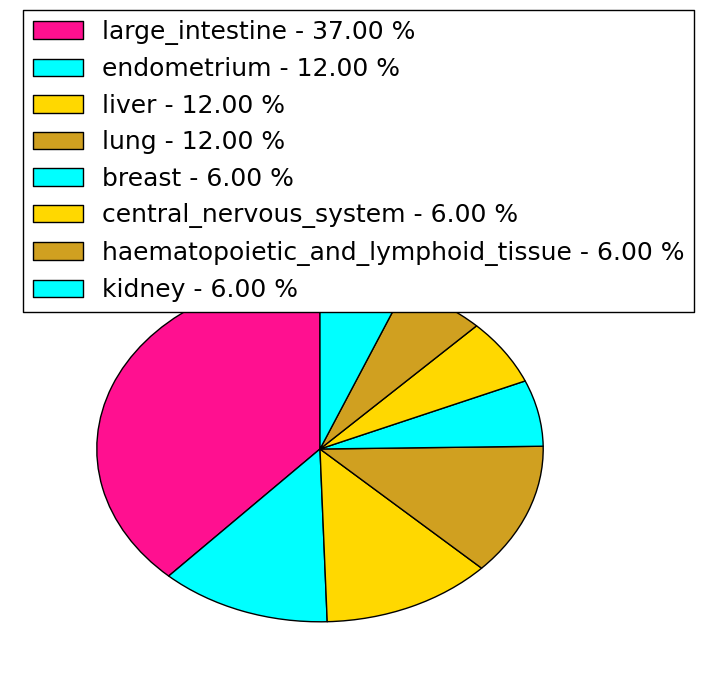 |  |
(# total SNVs=1) | (# total SNVs=0) |
 |
| Top |
| * When you move the cursor on each content, you can see more deailed mutation information on the Tooltip. Those are primary_site,primary_histology,mutation(aa),pubmedID. |
| GRCh37 position | Mutation(aa) | Unique sampleID count |
| chr22:28269793-28269793 | p.A156D | 2 |
| chr22:28306975-28306975 | p.T58T | 2 |
| chr22:28307060-28307060 | p.S30N | 2 |
| chr22:28292579-28292579 | p.I111I | 1 |
| chr22:28310311-28310311 | p.V15V | 1 |
| chr22:28256204-28256204 | p.C187F | 1 |
| chr22:28292602-28292602 | p.K104Q | 1 |
| chr22:28310333-28310333 | p.R8H | 1 |
| chr22:28256213-28256213 | p.S184N | 1 |
| chr22:28292612-28292612 | p.N100N | 1 |
| Top |
|
 |
| Point Mutation/ Tissue ID | 1 | 2 | 3 | 4 | 5 | 6 | 7 | 8 | 9 | 10 | 11 | 12 | 13 | 14 | 15 | 16 | 17 | 18 | 19 | 20 |
| # sample | 1 | 8 | 1 | 1 | 1 | 2 | 1 | 3 | 2 | 3 | ||||||||||
| # mutation | 1 | 7 | 1 | 1 | 1 | 2 | 1 | 3 | 2 | 3 | ||||||||||
| nonsynonymous SNV | 3 | 1 | 1 | 1 | 1 | 3 | 2 | 3 | ||||||||||||
| synonymous SNV | 1 | 4 | 2 |
| cf) Tissue ID; Tissue type (1; BLCA[Bladder Urothelial Carcinoma], 2; BRCA[Breast invasive carcinoma], 3; CESC[Cervical squamous cell carcinoma and endocervical adenocarcinoma], 4; COAD[Colon adenocarcinoma], 5; GBM[Glioblastoma multiforme], 6; Glioma Low Grade, 7; HNSC[Head and Neck squamous cell carcinoma], 8; KICH[Kidney Chromophobe], 9; KIRC[Kidney renal clear cell carcinoma], 10; KIRP[Kidney renal papillary cell carcinoma], 11; LAML[Acute Myeloid Leukemia], 12; LUAD[Lung adenocarcinoma], 13; LUSC[Lung squamous cell carcinoma], 14; OV[Ovarian serous cystadenocarcinoma ], 15; PAAD[Pancreatic adenocarcinoma], 16; PRAD[Prostate adenocarcinoma], 17; SKCM[Skin Cutaneous Melanoma], 18:STAD[Stomach adenocarcinoma], 19:THCA[Thyroid carcinoma], 20:UCEC[Uterine Corpus Endometrial Carcinoma]) |
| Top |
| * We represented just top 10 SNVs. When you move the cursor on each content, you can see more deailed mutation information on the Tooltip. Those are primary_site, primary_histology, mutation(aa), pubmedID. |
| Genomic Position | Mutation(aa) | Unique sampleID count |
| chr22:28306975 | p.T58T,PITPNB | 2 |
| chr22:28306962 | p.K104Q,PITPNB | 1 |
| chr22:28290544 | p.T99T,PITPNB | 1 |
| chr22:28292561 | p.P77P,PITPNB | 1 |
| chr22:28306976 | p.R73S,PITPNB | 1 |
| chr22:28292563 | p.V68L,PITPNB | 1 |
| chr22:28307087 | p.T239T,PITPNB | 1 |
| chr22:28292578 | p.H63Y,PITPNB | 1 |
| chr22:28310311 | p.V209I,PITPNB | 1 |
| chr22:28292579 | p.L195M,PITPNB | 1 |
| * Copy number data were extracted from TCGA using R package TCGA-Assembler. The URLs of all public data files on TCGA DCC data server were gathered on Jan-05-2015. Function ProcessCNAData in TCGA-Assembler package was used to obtain gene-level copy number value which is calculated as the average copy number of the genomic region of a gene. |
 |
| cf) Tissue ID[Tissue type]: BLCA[Bladder Urothelial Carcinoma], BRCA[Breast invasive carcinoma], CESC[Cervical squamous cell carcinoma and endocervical adenocarcinoma], COAD[Colon adenocarcinoma], GBM[Glioblastoma multiforme], Glioma Low Grade, HNSC[Head and Neck squamous cell carcinoma], KICH[Kidney Chromophobe], KIRC[Kidney renal clear cell carcinoma], KIRP[Kidney renal papillary cell carcinoma], LAML[Acute Myeloid Leukemia], LUAD[Lung adenocarcinoma], LUSC[Lung squamous cell carcinoma], OV[Ovarian serous cystadenocarcinoma ], PAAD[Pancreatic adenocarcinoma], PRAD[Prostate adenocarcinoma], SKCM[Skin Cutaneous Melanoma], STAD[Stomach adenocarcinoma], THCA[Thyroid carcinoma], UCEC[Uterine Corpus Endometrial Carcinoma] |
| Top |
| Gene Expression for PITPNB |
| * CCLE gene expression data were extracted from CCLE_Expression_Entrez_2012-10-18.res: Gene-centric RMA-normalized mRNA expression data. |
 |
| * Normalized gene expression data of RNASeqV2 was extracted from TCGA using R package TCGA-Assembler. The URLs of all public data files on TCGA DCC data server were gathered at Jan-05-2015. Only eight cancer types have enough normal control samples for differential expression analysis. (t test, adjusted p<0.05 (using Benjamini-Hochberg FDR)) |
 |
| Top |
| * This plots show the correlation between CNV and gene expression. |
: Open all plots for all cancer types
 |
|
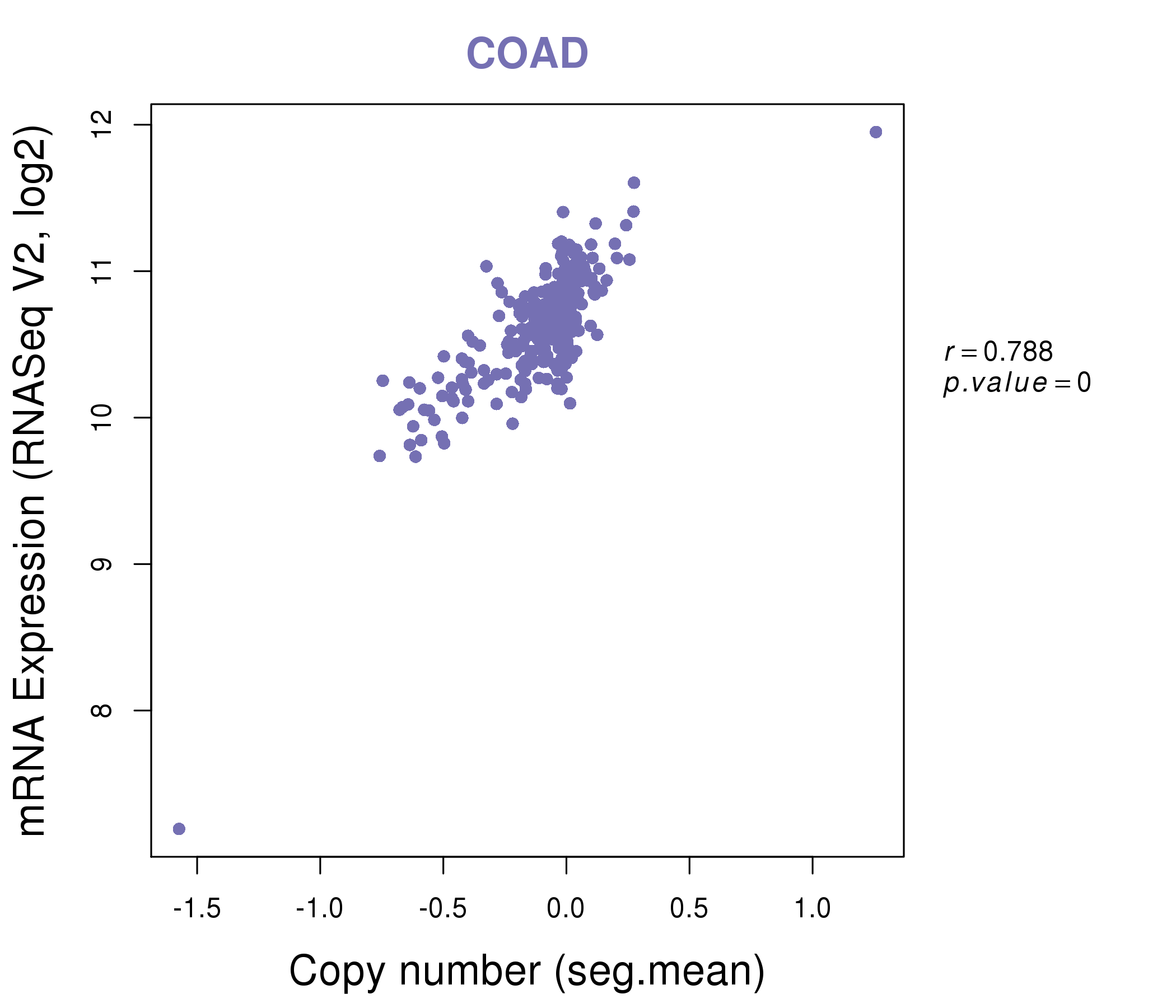 |
|
| Top |
| Gene-Gene Network Information |
| * Co-Expression network figures were drawn using R package igraph. Only the top 20 genes with the highest correlations were shown. Red circle: input gene, orange circle: cell metabolism gene, sky circle: other gene |
: Open all plots for all cancer types
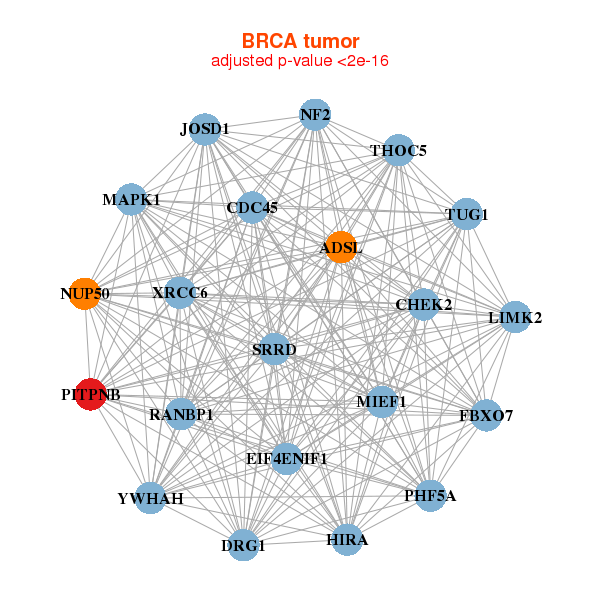 |
|
| ADSL,CDC45,CHEK2,DRG1,EIF4ENIF1,FBXO7,HIRA, JOSD1,LIMK2,MAPK1,NF2,NUP50,PHF5A,PITPNB, RANBP1,MIEF1,SRRD,THOC5,TUG1,XRCC6,YWHAH | ABCE1,ACTR3,MCMBP,CTSO,CTTNBP2NL,ERI1,GNAI3, GOLPH3,HIAT1,HIATL1,MAK16,NRAS,NUDCD1,NUS1, PITPNB,RAB11A,SSR1,TM9SF3,UBLCP1,UFM1,YES1 |
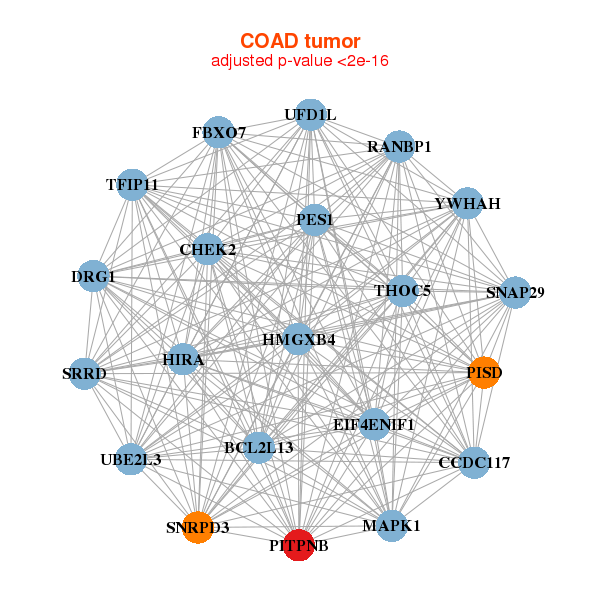 |
|
| BCL2L13,CCDC117,CHEK2,DRG1,EIF4ENIF1,FBXO7,HIRA, HMGXB4,MAPK1,PES1,PISD,PITPNB,RANBP1,SNAP29, SNRPD3,SRRD,TFIP11,THOC5,UBE2L3,UFD1L,YWHAH | C1orf216,CALU,CLIP4,COPZ2,DENND5A,FGF2,KLHL5, MAP9,PITPNB,PLS3,QKI,RAB23,IFT22,RASSF8, RBMS1,RDX,RHOQ,SAE1,SPG20,STX2,ZEB1 |
| * Co-Expression network figures were drawn using R package igraph. Only the top 20 genes with the highest correlations were shown. Red circle: input gene, orange circle: cell metabolism gene, sky circle: other gene |
: Open all plots for all cancer types
| Top |
: Open all interacting genes' information including KEGG pathway for all interacting genes from DAVID
| Top |
| Pharmacological Information for PITPNB |
| There's no related Drug. |
| Top |
| Cross referenced IDs for PITPNB |
| * We obtained these cross-references from Uniprot database. It covers 150 different DBs, 18 categories. http://www.uniprot.org/help/cross_references_section |
: Open all cross reference information
|
Copyright © 2016-Present - The Univsersity of Texas Health Science Center at Houston @ |







